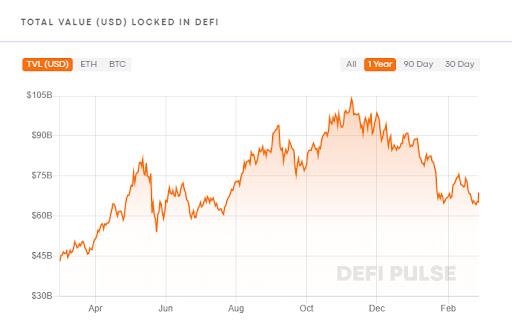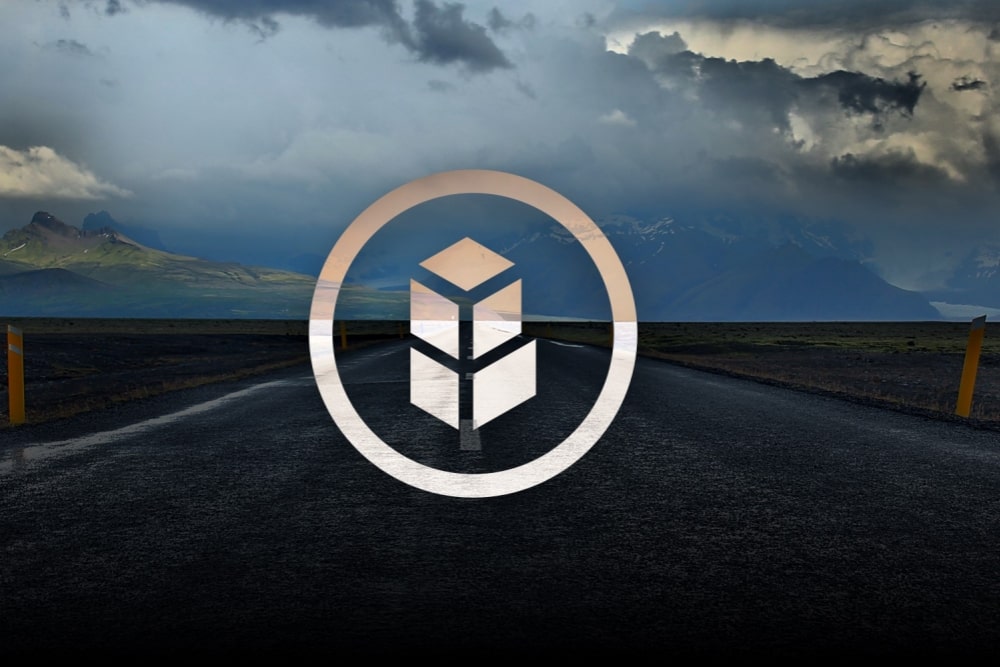The blockchain and cryptocurrency ecosystem has experienced enormous growth in value and mass adoption rates. The launch of decentralized finance (DeFi) led to the explosive growth of protocols and projects on multiple scalable, transparent, and secure blockchain networks.
As the DeFi sector grew, projects were majorly built on the Ethereum blockchain. But as demand for the products rose, the blockchain experienced scalability issues. This led to projects moving to layer 2 scalability options such as Avalanche, Fantom and Polygon.
Today, the DeFi ecosystem stands at $69.91 billion in total value locked (TVL), according to DeFi Pulse. This figure is largely influenced by the growth of decentralized exchanges (DEXs) and automated market makers (AMMs). It is the latter that really pushed the narrative of DeFi in the summer of 2020, where these DApps gained massive popularity.

The explosive growth of DeFi in the past year (Image: DeFi Pulse)
Understanding the growth of AMMs on DEXs
Automated market makers, or AMMs, as the word reads, are automatic platforms on a decentralized exchange that do not rely on the conventional order books to complete trades. Instead, AMMs use mathematical formulas to calculate the price of assets and complete trades on the DEX. Additionally, AMMs also provide market liquidity from different liquidity pools, which means traders do not need to match with a counterparty trade to complete their trade.

Image: (03school)
With the launch of AMMs, DEXs have become more popular. They facilitate the swapping of tokens in the liquidity pools via smart contracts or peer-to-peer contracts, which provide the price and liquidity necessary to execute trades.
The first AMM was launched in 2017 by Bancor. However, the real breakthrough for the innovation came in 2018 with the launch of Ethereum-based Uniswap DEX. Within two years, Uniswap took over the DeFi ecosystem due to its simple user interface and broad listing system, bringing to light the power of AMMs.
Since the launch of Uniswap, several spinoffs have emerged, such as Sushiswap, to challenge the dominance of Uniswap, leeching liquidity from one another in what is now referred to as “AMM wars”.
With over 300 AMMs in effect today, according to DeFi Llama, users are torn on which one to choose, each offering its own unique features to lure users. Nonetheless, most of these protocols still face several challenges in onboarding users, the greatest being the issue of Impermanent Loss (IL).
Unsurprisingly, it is Bancor Network, the first-ever AMM, which is leading in providing solutions to this problem.
How Bancor Network improves regular DeFi protocols
Following its launch in 2017, the Bancor network development team has been upgrading its trading mechanisms to make trading more effective for its users. In October 2020, Bancor introduced the Bancor V2.1 upgrade, providing a solution to the rampant cases of Impermanent Loss. Termed the Impermanent Loss Protection Program, Bancor V2.1 allowed users to provide liquidity in single token liquidity pools, as opposed to the dual token LPs on Uniswap, Sushiswap, and other AMMs.

While the IL protection program minimized cases of Impermanent Loss, the solution increased the transaction fees. This is because users need to swap assets for BNT tokens first before swapping to their desired currency. For instance, a trade from ETH to WBTC would see the trader first convert their ETH to BNT, then BNT to WBTC, doubling the transaction fees.
Late last year, Bancor introduced its third upgrade, Bancor V3, to solve this issue, while eliminating IL on liquidity pools. The platform announced the “Omnipool”, a single pool to stake your BNT and earn yield from the entire network. The single asset pool simplifies the process of earning yield via BNT, as you don’t need to move your BNT across different pools to earn the most rewards and fees.
Additionally, Onmipool reduces the cost of transactions by completing all single asset liquidity pools trades in a single transaction. With single-hop trades, Bancor can attract more trading fees with the same level of liquidity, making the protocol more capital efficient. Additionally, staking will also become cheaper as the protocol will also make withdrawals with far fewer transactions.
Bancor differentiating from other AMMs
Bancor V3 will also differentiate itself from the rest of DEXs by introducing first-to-market features for traders and investors on the platform. Apart from providing IL protection and lowering the transaction fees, Bancor V3 will allow IL protection from the first day of staking. In Bancor v2.1, 100% IL protection was accrued by staking your tokens in a pool for 100 days or more; now it is achieved instantly.
Furthermore, Bancor V3 also introduces an auto-compounding feature that instantly re-adds rewards gained into your liquidity pool stake. This boosts the overall liquidity on the platform while giving traders an opportunity to earn more rewards without manually re-investing their rewards.
The liquidity pools on Bancor V3 do not have any deposit limits via the introduction of ‘infinity pools’, allowing depositors to stake as much as they want. Finally, the platform introduces a dual rewards system providing liquidity providers with extra rewards paid out with another crypto-token, other than the native BNT token.










